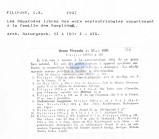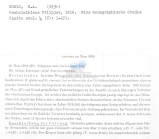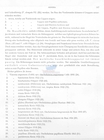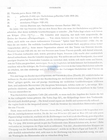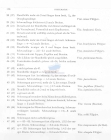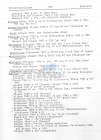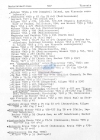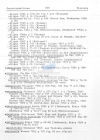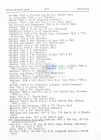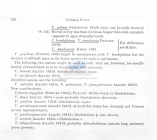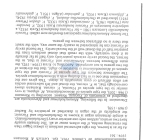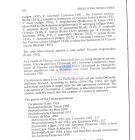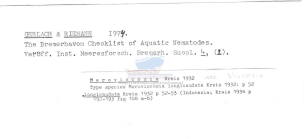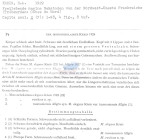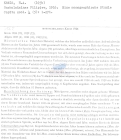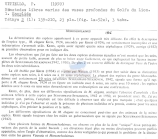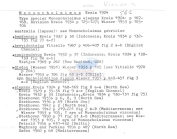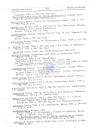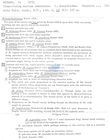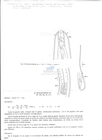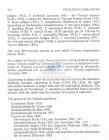WoRMS taxon details
Viscosia de Man, 1890
2570 (urn:lsid:marinespecies.org:taxname:2570)
accepted
Genus
Meroviscosia Kreis, 1932 · unaccepted (Lorenzen, 1981, 1994 p 251:...)
Lorenzen, 1981, 1994 p 251: synonymized with Viscosia
Mononcholaimus Kreis, 1924 · unaccepted ((Lorenzen, 1994 translated version))
- Species Viscosia abyssorum (Allgén, 1933) Wieser, 1953
- Species Viscosia angustata (Cobb, 1890) Kreis, 1934
- Species Viscosia antarctica Allgén, 1959
- Species Viscosia bandaensilis Lorenzen, 1981
- Species Viscosia bandaensis Kreis, 1932
- Species Viscosia bayensis Keppner, 1987
- Species Viscosia brachydonta Allgén, 1959
- Species Viscosia brachylaima Filipjev, 1927
- Species Viscosia brachylaimoides Chitwood, 1937
- Species Viscosia brevicaudata Mawson, 1958
- Species Viscosia brevidentata (Vitiello, 1967) Lorenzen, 1981
- Species Viscosia brevilaima Allgén, 1959
- Species Viscosia carnleyensis (Ditlevsen, 1921) Kreis, 1932
- Species Viscosia cobbi Filipjev, 1918
- Species Viscosia conicaudata (Kreis, 1932) Lorenzen, 1981
- Species Viscosia coomansi Smol & Sharma, 1984
- Species Viscosia crassa Kreis, 1932
- Species Viscosia cryptodentata Allgén, 1959
- Species Viscosia diodon (Wieser, 1951) Lorenzen, 1981
- Species Viscosia dossena Leduc & Zhao, 2023
- Species Viscosia elegans (Kreis, 1924) Lorenzen, 1981
- Species Viscosia elongata Filipjev, 1922
- Species Viscosia epapillosa Platonova, 1971
- Species Viscosia erasmi Furstenberg & Vincx, 1989
- Species Viscosia falklandiae Allgén, 1959
- Species Viscosia fatigans Filipjev, 1946
- Species Viscosia filiformis (Kreis, 1932) Lorenzen, 1981
- Species Viscosia filipjevi Paramonov, 1929
- Species Viscosia floridana Keppner, 1987
- Species Viscosia franzii Boucher, 1977
- Species Viscosia glabra (Bastian, 1865) de Man, 1890
- Species Viscosia grahami Allgén, 1959
- Species Viscosia hanstroemi Wieser, 1953
- Species Viscosia heterolaima Smol & Sharma, 1984
- Species Viscosia isotonchula Kreis, 1932
- Species Viscosia keiensilis Lorenzen, 1981
- Species Viscosia keiensis Kreis, 1932
- Species Viscosia langrunensis (de Man, 1890)
- Species Viscosia leptolaima Kreis, 1932
- Species Viscosia linstowi (de Man, 1904)
- Species Viscosia longicaudatoides Vu Thanh & Gagarin, 2013
- Species Viscosia longidentata (Schuurmans Stekhoven, 1931)
- Species Viscosia longissima Filipjev, 1946
- Species Viscosia macramphida Chitwood, 1951
- Species Viscosia macrobursata Keppner, 1987
- Species Viscosia macrorhopalocerca Kreis, 1932
- Species Viscosia megalaima (Ditlevsen, 1928) Hope & Murphy, 1972
- Species Viscosia meridionalis Kreis, 1932
- Species Viscosia microseta Wieser, 1953
- Species Viscosia minor Filipjev, 1918
- Species Viscosia minudonta Vitiello, 1970
- Species Viscosia nona Filipjev, 1946
- Species Viscosia norvegica (Allgén, 1946) Lorenzen, 1981
- Species Viscosia nuda Kreis, 1932
- Species Viscosia oncholaimelloides Wieser & Hopper, 1967
- Species Viscosia palmae Schuurmans Stekhoven, 1942
- Species Viscosia papillata Chitwood, 1951
- Species Viscosia papillatoides Chitwood, 1960
- Species Viscosia papillatula Lorenzen, 1981
- Species Viscosia papillosa (Eberth, 1863) Kreis, 1934
- Species Viscosia parafalklandiae Allgén, 1959
- Species Viscosia paralinstowi Chitwood, 1937
- Species Viscosia parapellucida (Allgén, 1959) Gerlach & Riemann, 1974
- Species Viscosia parasetosa (Kreis, 1932) Lorenzen, 1981
- Species Viscosia paridentata Kreis, 1932
- Species Viscosia parva Kreis, 1929
- Species Viscosia pedroensis Allgén, 1947
- Species Viscosia pellucida (Cobb, 1898) Filipjev, 1918
- Species Viscosia poseidonica Belogurov & Belogurova, 1977
- Species Viscosia profunda (Vitiello, 1970) Lorenzen, 1981
- Species Viscosia propinqua Allgén, 1959
- Species Viscosia pseudoglabra Kreis, 1932
- Species Viscosia pygmaea Vu Thanh & Gagarin, 2013
- Species Viscosia rectangulata Wieser, 1953
- Species Viscosia rustica (Kreis, 1929) Lorenzen, 1974
- Species Viscosia sedata Gagarin & Thanh, 2007
- Species Viscosia separabilis (Wieser, 1953) Lorenzen, 1981
- Species Viscosia setosa (Kreis, 1932) Lorenzen, 1981
- Species Viscosia similis Allgén, 1959
- Species Viscosia stenolaima Filipjev, 1927
- Species Viscosia stenostoma Platonova, 1971
- Species Viscosia subantarctica Allgén, 1959
- Species Viscosia tasmaniensis (Allgen, 1927) Lorenzen, 1981
- Species Viscosia tenuilaima Allgén, 1959
- Species Viscosia tenuissima Allgén, 1959
- Species Viscosia tumidula Wieser, 1959
- Species Viscosia viscosa (Bastian, 1865) de Man, 1890
- Species Viscosia viscosula Lorenzen, 1981
- Species Viscosia wieseri Mawson, 1958
- Species Viscosia aegyptica (Steiner, 1921) accepted as Oncholaimus aegypticus Steiner, 1921
- Species Viscosia brevidentatus (Vitiello, 1967) accepted as Viscosia brevidentata (Vitiello, 1967) Lorenzen, 1981
- Species Viscosia donsi Allgén, 1947 accepted as Oncholaimus donsi (Allgén, 1947) Wieser, 1953
- Species Viscosia longicaudata (unaccepted > nomen nudum)
- Species Viscosia longidentatus (Schuurmans Stekhoven, 1931) accepted as Viscosia longidentata (Schuurmans Stekhoven, 1931)
- Species Viscosia micoletzkyi Chitwood, 1951 accepted as Viscosia glabra (Bastian, 1865) de Man, 1890
- Species Viscosia pacifica Allgén, 1951 accepted as Oncholaimus rapax Kreis, 1932
- Species Viscosia paralangrunensis Allgén, 1947 accepted as Oncholaimus paralangrunensis (Allgén, 1947)
- Species Viscosia pellucida Allgén, 1959 accepted as Viscosia parapellucida (Allgén, 1959) Gerlach & Riemann, 1974
- Species Viscosia profundus (Vitiello, 1970) accepted as Viscosia profunda (Vitiello, 1970) Lorenzen, 1981 (proper gender agreement)
- Species Viscosia rusticus (Kreis, 1929) accepted as Viscosia rustica (Kreis, 1929) Lorenzen, 1974 (proper gender agreement)
- Species Viscosia scanica Allgén, 1935 accepted as Oncholaimus scanicus (Allgén, 1935) Wieser, 1953
- Species Viscosia taboguillensis Allgén, 1947 accepted as Adoncholaimus taboguillensis (Allgén, 1947) Wieser, 1953
- Species Viscosia viscosia (Bastian, 1865) accepted as Viscosia viscosa (Bastian, 1865) de Man, 1890 (Spelling variation)
- Species Viscosia dubiosa Kreis, 1932 (uncertain > taxon inquirendum)
- Species Viscosia gabriolae (Allgen, 1951) Lorenzen, 1981 (uncertain > taxon inquirendum)
- Species Viscosia glaberoides (Allgen, 1932) Lorenzen, 1981 (uncertain > taxon inquirendum)
- Species Viscosia klatti (Allgen, 1941) Lorenzen, 1981 (uncertain > taxon inquirendum)
- Species Viscosia nijhoffi Allgén, 1935 (uncertain > taxon inquirendum)
- Species Viscosia nordgaardi Allgén, 1940 (uncertain > taxon inquirendum)
- Species Viscosia parapedroensis Allgén, 1947 (uncertain > taxon inquirendum)
- Species Viscosia pseudosegmentata Allgén, 1947 (uncertain > taxon inquirendum)
- Species Viscosia strandi Allgén, 1935 (uncertain > taxon inquirendum)
marine, brackish, fresh
Not documented
Nemys eds. (2024). Nemys: World Database of Nematodes. Viscosia de Man, 1890. Accessed through: World Register of Marine Species at: https://www.marinespecies.org/aphia.php?p=taxdetails&id=2570 on 2024-09-20
Date
action
by
2004-12-21 15:54:05Z
created
db_admin
2006-09-29 11:38:53Z
changed
Martinez, Olga
![]() The webpage text is licensed under a Creative Commons Attribution 4.0 License
The webpage text is licensed under a Creative Commons Attribution 4.0 License
original description
(of Mononcholaimus Kreis, 1924) Kreis, H. A. (1924). Zur Kenntnis der freilebenden marinen Nematoden. <em>Schriften für Süßwasser und Meereskunde, Büsum.</em> 2: 157-170.
page(s): 13-14 [details] Available for editors [request]
[request]
original description (of Meroviscosia Kreis, 1932) Kreis, H. A. (1934). Oncholaiminae Filipjev 1916. Eine monographische Studie. <em>Capita Zoologica.</em> 4 (5): 1-271.
page(s): 52 [details]
basis of record Nemaslan: Biodiversity of Antarctic Nematodes (2004). (look up in IMIS) [details]
additional source Brunel, P., L. Bosse & G. Lamarche. (1998). Catalogue of the marine invertebrates of the estuary and Gulf of St. Lawrence. <em>Canadian Special Publication of Fisheries and Aquatic Sciences, 126.</em> 405 pp. (look up in IMIS) [details] Available for editors [request]
[request]
additional source Warwick, R. M. (1973). Freeliving marine nematodes from the Indian Ocean. <em>Bull. Br. Mus. Nat. Hist. (Zool.).</em> 25 (3):85-117. [details] Available for editors [request]
[request]
additional source Neave, Sheffield Airey. (1939-1996). Nomenclator Zoologicus vol. 1-10 Online. <em>[Online Nomenclator Zoologicus at Checklistbank. Ubio link has gone].</em> , available online at https://www.checklistbank.org/dataset/126539/about [details]
additional source Various Authors (2000). Nematode filing cabinet of the Marine Biology Section Ugent - in combination with the NemasLan Ms-Access database (published on CD-Rom, 2000) (look up in IMIS) [details]
additional source Gerlach, S. A. (1957). Marine Nematoden aus dem Mangrove-Gebiet von Cananéia (Brasilianische Meeres-Nematoden III). <em>Abh. math.-naturw. Kl. Akad. Wiss. Mainz.</em> 5: 129-176. [details] Available for editors [request]
[request]
additional source Vanaverbeke, J., K. Soetaert, C. Heip & A. Vanreusel. (1997). The metazoan meiobenthos along the continental slope of the Goban Spur (NE Atlantic). <em>Journal of Sea Research.</em> 38:93-107. [details] Available for editors [request]
[request]
additional source Verschelde, D.; Nicholas, W.; Vincx, M. (2006). A Review of the Genera Croconema Cobb, 1920 and Pseudochromadora Daday, 1899 (Nematoda, Desmodoroidea): New Species from the Coasts of Kenya and Australia. <em>Hydrobiologia.</em> 571, 17-40. (look up in IMIS) [details]
additional source Gerlach, S. A. (1957). Marine Nematoden von der Kongo-Mündung. <em>Bull. Inst. r. Sci. nat. Belg.</em> 33 (28): 1-16. [details] Available for editors [request]
[request]
additional source Van de Velde, B. (2003). Evaluatie en opvolging van een strandverstoringsexperiment met behulp van mariene nematoden. <em>Lic. Thesis UGent.</em> [details] Available for editors [request]
[request]
additional source Buhl-Mortensen, L.; Vanreusel, A.; Gooday, A. J.; Levin, L. A.; Priede, I. G.; Buhl-Mortensen, P.; Gheerardyn, H.; King, N. J.; Raes, M. (2010). Biological structures as a source of habitat heterogeneity and biodiversity on the deep ocean margins. <em>Marine Ecology.</em> 31: 21-50. [details] Available for editors [request]
[request]
additional source Jensen, P. (1986). The nematode fauna in the sulphide-rich brine seep and adjacent bottoms of the East Flower Garden, NW Gulf of Mexico. <em>IV. Ecological aspects. Marine Biology.</em> 92: 489-503. [details] Available for editors [request]
[request]
additional source Commito, J.A. & G. Tita. (2002). Differential dispersal rates in an intertidal meiofauna assemblage. <em>Journal of Experimental Marine Biology and Ecology.</em> 268(2): 237-256. [details] Available for editors [request]
[request]
additional source Gobin, J. F. (2007). Free-living marine nematodes of hard bottom substrates in Trinidad and Tobago, West Indies. <em>Bulletin of Marine Science.</em> 81(1): 73–84. [details]
additional source Li, J.; Vincx, M. (1993). The temporal variation of intertidal nematodes in the Westerschelde. I. The importance of an estuarine gradient. <em>Netherlands Journal of Aquatic Ecology.</em> 27 (2-4): 319-326. (look up in IMIS) [details] Available for editors [request]
[request]
additional source Lorenzen, S. (1974). Die Nematodenfauna der sublitoralen Region der Deutschen Bucht, insbesondere im Titan-Abwassergebiet bei Helgoland. <em>Veröff. Inst. Meeresforsch. Bremerh.</em> 14: 305-327. [details] Available for editors [request]
[request]
additional source Maria, T. F.; Esteves, A. M.; Smol, N.; Vanreusel, A.; Decraemer, W. (2008). Nematodes from sandy beaches of Guanabara Bay, Rio de Janeiro, Brazil. <em>Biociências, Porto Alegre.</em> 16 (2), 92-103. [details] Available for editors [request]
[request]
additional source Austen, M. C.; Widdicombe, S. (1998). Experimental evidence of effects of the heart urchin Brissopsis lyrifera on associated subtidal meiobenthic nematode communities. <em>Journal of Experimental Marine Biology and Ecology.</em> 222: 219-238. [details] Available for editors [request]
[request]
additional source Miljutin, D. M.; Gad, G.; Miljutina, M. M.; Mokievsky, V. O.; Fonseca-Genevois, V.; Esteves, A. M. (2010). The state of knowledge on deep-sea nematode taxonomy: how many valid species are known down there?. <em>Marine Biodiversity.</em> 40(3): 143-159., available online at https://doi.org/10.1007/s12526-010-0041-4 [details] Available for editors [request]
[request]
additional source Integrated Taxonomic Information System (ITIS). , available online at http://www.itis.gov [details]
additional source Da Rocha, C. M. C.; Venekey, V.; Bezerra, T. N. C.; Souza, R. B. (2006). Phytal marine nematode assemblages and their relation with the macrophytes structural complexity in a Brazilian tropical rocky beach. <em>Hydrobiologia.</em> 553:219-230. [details] Available for editors [request]
[request]
additional source Gheskiere, T. (2000). Structurele diversiteit van nematodengemeenschappen van de Bligh Bank (Zuidelijke Bocht van de Noordzee). [details] Available for editors [request]
[request]
additional source Guo, Y.; Helléouet, M.-N.; Boucher, G. (2008). Spatial patterns of meiofauna and diversity of nematode species assemblages in the Uvea lagoon (Loyalty Islands, South Pacific). <em>Journal of the Marine Biological Association of the United Kingdom.</em> 88(5), 931–940. [details] Available for editors [request]
[request]
additional source Steyaert, M.; Moodley, L.; Vanaverbeke, J.; Vandewiele, S.; Vincx, M. (2005). Laboratory experiments on the infaunal activity of intertidal nematodes. <em>Hydrobiologia.</em> 540(1-3): 217-223. (look up in IMIS), available online at https://doi.org/10.1007/s10750-004-7145-4 [details] Available for editors [request]
[request]
additional source Van Gaever, S.; Olu, K.; Derycke, S.; Vanreusel, A. (2009). Metazoan meiofaunal communities at cold seeps along the Norwegian margin: Influence of habitat heterogeneity and evidence for connection with shallow-water habitats. <em>Deep Sea Research Part I: Oceanographic Research Papers.</em> 56(5): 772-785., available online at https://doi.org/10.1016/j.dsr.2008.12.015 [details] Available for editors [request]
[request]
additional source Van Gaever, S.; Vanreusel, A.; Hughes, J.; Bett, B.; Kiriakoulakis, K. (1999). The macro- and micro-scale patchiness of meiobenthos associated with the Darwin Mounds (north-east Atlantic). <em>Journal of the Marine Biological Association of the UK.</em> 84(3): 547-556., available online at https://doi.org/10.1017/s0025315404009555h [details] Available for editors [request]
[request]
additional source Venekey, V.; Fonseca-Genevois, V.; Santos, P. J. P. (2010). Biodiversity of free-living marine nematodes on the coast of Brazil: a review. <em>Zootaxa.</em> 2568: 39–66. [details] Available for editors [request]
[request]
additional source De Oliveira Pinto, T.K.,Netto, S.A., Esteves, A.M., De Castro, F.J.V., Neres, P.F. and Da Silva, M.C. (2021). Free-living freshwater nematodes from Brazil: checklist of genera and regional patterns of diversity. <em>Nematology.</em> 0 (2021) 1-14. [details] Available for editors [request]
[request]
ecology source Vanaverbeke, J.; Deprez, T.; Vincx, M. (2007). Changes in nematode communities at the long-term sand extraction site of the Kwintebank (Southern Bight of the North Sea). <em>Marine Pollution Bulletin.</em> 54(9): 1351-1360. (look up in IMIS), available online at https://doi.org/10.1016/j.marpolbul.2007.05.019 [details] Available for editors [request]
[request]
ecology source Raes, M.; De Troch, M.; Ndaro, S. G. M.; Muthumbi, A.; Guilini, K.; Vanreusel, A. (2007). The structuring role of microhabitat type in coral degradation zones: a case study with marine nematodes from Kenya and Zanzibar. <em>Coral Reefs.</em> 26 (1): 13-126. [details] Available for editors [request]
[request]
ecology source Raes, M.; Vanreusel, A. (2006). Microhabitat type determines the composition of nematode communities associated with sediment-clogged cold-water coral framework in the Porcupine Seabight (NE Atlantic). <em>Deep-Sea Research Part I.</em> 53 (12): 880-1894. [details] Available for editors [request]
[request]
ecology source Van Colen, C.; Montserrat, F.; Verbist, K.; Vincx, M.; Steyaert, M.; Vanaverbeke, J.; Herman, P.; Degraer, S.; Ysebaert, T. (2009). Tidal flat nematode responses to hypoxia and subsequent macrofauna-mediated alterations of sediment properties. <em>Marine Ecology Progress Series.</em> 381: 189-197. (look up in IMIS), available online at https://doi.org/10.3354/meps07914 [details] Available for editors [request]
[request]
ecology source Dando, P. R.; Austen, M. C.; Burke, Jr. R. A.; Kendall, M. A.; Kennicutt, II M. C.; Judd, A. G.; Moore, D. C.; O'Hara, S. C. M.; Schmaljohann, R.; Southward, A. J. (1991). Ecology of a North Sea pockmark with an active methane seep. <em>Marine Ecology Progress Series.</em> 70: 49-63. [details] Available for editors [request]
[request]
ecology source Fonsêca-Genevois, V.da., P.J. Somerfield, M.H. Baeta-Neves, R. Coutinho & T. Moens. (2006). Colonization and early succession on artificial hard substrata by meiofauna. Marine Biology 148(5):1039-1050., available online at https://doi.org/10.1007/s00227-005-0145-8 [details] Available for editors [request]
[request]
page(s): 13-14 [details] Available for editors
original description (of Meroviscosia Kreis, 1932) Kreis, H. A. (1934). Oncholaiminae Filipjev 1916. Eine monographische Studie. <em>Capita Zoologica.</em> 4 (5): 1-271.
page(s): 52 [details]
basis of record Nemaslan: Biodiversity of Antarctic Nematodes (2004). (look up in IMIS) [details]
additional source Brunel, P., L. Bosse & G. Lamarche. (1998). Catalogue of the marine invertebrates of the estuary and Gulf of St. Lawrence. <em>Canadian Special Publication of Fisheries and Aquatic Sciences, 126.</em> 405 pp. (look up in IMIS) [details] Available for editors
additional source Warwick, R. M. (1973). Freeliving marine nematodes from the Indian Ocean. <em>Bull. Br. Mus. Nat. Hist. (Zool.).</em> 25 (3):85-117. [details] Available for editors
additional source Neave, Sheffield Airey. (1939-1996). Nomenclator Zoologicus vol. 1-10 Online. <em>[Online Nomenclator Zoologicus at Checklistbank. Ubio link has gone].</em> , available online at https://www.checklistbank.org/dataset/126539/about [details]
additional source Various Authors (2000). Nematode filing cabinet of the Marine Biology Section Ugent - in combination with the NemasLan Ms-Access database (published on CD-Rom, 2000) (look up in IMIS) [details]
additional source Gerlach, S. A. (1957). Marine Nematoden aus dem Mangrove-Gebiet von Cananéia (Brasilianische Meeres-Nematoden III). <em>Abh. math.-naturw. Kl. Akad. Wiss. Mainz.</em> 5: 129-176. [details] Available for editors
additional source Vanaverbeke, J., K. Soetaert, C. Heip & A. Vanreusel. (1997). The metazoan meiobenthos along the continental slope of the Goban Spur (NE Atlantic). <em>Journal of Sea Research.</em> 38:93-107. [details] Available for editors
additional source Verschelde, D.; Nicholas, W.; Vincx, M. (2006). A Review of the Genera Croconema Cobb, 1920 and Pseudochromadora Daday, 1899 (Nematoda, Desmodoroidea): New Species from the Coasts of Kenya and Australia. <em>Hydrobiologia.</em> 571, 17-40. (look up in IMIS) [details]
additional source Gerlach, S. A. (1957). Marine Nematoden von der Kongo-Mündung. <em>Bull. Inst. r. Sci. nat. Belg.</em> 33 (28): 1-16. [details] Available for editors
additional source Van de Velde, B. (2003). Evaluatie en opvolging van een strandverstoringsexperiment met behulp van mariene nematoden. <em>Lic. Thesis UGent.</em> [details] Available for editors
additional source Buhl-Mortensen, L.; Vanreusel, A.; Gooday, A. J.; Levin, L. A.; Priede, I. G.; Buhl-Mortensen, P.; Gheerardyn, H.; King, N. J.; Raes, M. (2010). Biological structures as a source of habitat heterogeneity and biodiversity on the deep ocean margins. <em>Marine Ecology.</em> 31: 21-50. [details] Available for editors
additional source Jensen, P. (1986). The nematode fauna in the sulphide-rich brine seep and adjacent bottoms of the East Flower Garden, NW Gulf of Mexico. <em>IV. Ecological aspects. Marine Biology.</em> 92: 489-503. [details] Available for editors
additional source Commito, J.A. & G. Tita. (2002). Differential dispersal rates in an intertidal meiofauna assemblage. <em>Journal of Experimental Marine Biology and Ecology.</em> 268(2): 237-256. [details] Available for editors
additional source Gobin, J. F. (2007). Free-living marine nematodes of hard bottom substrates in Trinidad and Tobago, West Indies. <em>Bulletin of Marine Science.</em> 81(1): 73–84. [details]
additional source Li, J.; Vincx, M. (1993). The temporal variation of intertidal nematodes in the Westerschelde. I. The importance of an estuarine gradient. <em>Netherlands Journal of Aquatic Ecology.</em> 27 (2-4): 319-326. (look up in IMIS) [details] Available for editors
additional source Lorenzen, S. (1974). Die Nematodenfauna der sublitoralen Region der Deutschen Bucht, insbesondere im Titan-Abwassergebiet bei Helgoland. <em>Veröff. Inst. Meeresforsch. Bremerh.</em> 14: 305-327. [details] Available for editors
additional source Maria, T. F.; Esteves, A. M.; Smol, N.; Vanreusel, A.; Decraemer, W. (2008). Nematodes from sandy beaches of Guanabara Bay, Rio de Janeiro, Brazil. <em>Biociências, Porto Alegre.</em> 16 (2), 92-103. [details] Available for editors
additional source Austen, M. C.; Widdicombe, S. (1998). Experimental evidence of effects of the heart urchin Brissopsis lyrifera on associated subtidal meiobenthic nematode communities. <em>Journal of Experimental Marine Biology and Ecology.</em> 222: 219-238. [details] Available for editors
additional source Miljutin, D. M.; Gad, G.; Miljutina, M. M.; Mokievsky, V. O.; Fonseca-Genevois, V.; Esteves, A. M. (2010). The state of knowledge on deep-sea nematode taxonomy: how many valid species are known down there?. <em>Marine Biodiversity.</em> 40(3): 143-159., available online at https://doi.org/10.1007/s12526-010-0041-4 [details] Available for editors
additional source Integrated Taxonomic Information System (ITIS). , available online at http://www.itis.gov [details]
additional source Da Rocha, C. M. C.; Venekey, V.; Bezerra, T. N. C.; Souza, R. B. (2006). Phytal marine nematode assemblages and their relation with the macrophytes structural complexity in a Brazilian tropical rocky beach. <em>Hydrobiologia.</em> 553:219-230. [details] Available for editors
additional source Gheskiere, T. (2000). Structurele diversiteit van nematodengemeenschappen van de Bligh Bank (Zuidelijke Bocht van de Noordzee). [details] Available for editors
additional source Guo, Y.; Helléouet, M.-N.; Boucher, G. (2008). Spatial patterns of meiofauna and diversity of nematode species assemblages in the Uvea lagoon (Loyalty Islands, South Pacific). <em>Journal of the Marine Biological Association of the United Kingdom.</em> 88(5), 931–940. [details] Available for editors
additional source Steyaert, M.; Moodley, L.; Vanaverbeke, J.; Vandewiele, S.; Vincx, M. (2005). Laboratory experiments on the infaunal activity of intertidal nematodes. <em>Hydrobiologia.</em> 540(1-3): 217-223. (look up in IMIS), available online at https://doi.org/10.1007/s10750-004-7145-4 [details] Available for editors
additional source Van Gaever, S.; Olu, K.; Derycke, S.; Vanreusel, A. (2009). Metazoan meiofaunal communities at cold seeps along the Norwegian margin: Influence of habitat heterogeneity and evidence for connection with shallow-water habitats. <em>Deep Sea Research Part I: Oceanographic Research Papers.</em> 56(5): 772-785., available online at https://doi.org/10.1016/j.dsr.2008.12.015 [details] Available for editors
additional source Van Gaever, S.; Vanreusel, A.; Hughes, J.; Bett, B.; Kiriakoulakis, K. (1999). The macro- and micro-scale patchiness of meiobenthos associated with the Darwin Mounds (north-east Atlantic). <em>Journal of the Marine Biological Association of the UK.</em> 84(3): 547-556., available online at https://doi.org/10.1017/s0025315404009555h [details] Available for editors
additional source Venekey, V.; Fonseca-Genevois, V.; Santos, P. J. P. (2010). Biodiversity of free-living marine nematodes on the coast of Brazil: a review. <em>Zootaxa.</em> 2568: 39–66. [details] Available for editors
additional source De Oliveira Pinto, T.K.,Netto, S.A., Esteves, A.M., De Castro, F.J.V., Neres, P.F. and Da Silva, M.C. (2021). Free-living freshwater nematodes from Brazil: checklist of genera and regional patterns of diversity. <em>Nematology.</em> 0 (2021) 1-14. [details] Available for editors
ecology source Vanaverbeke, J.; Deprez, T.; Vincx, M. (2007). Changes in nematode communities at the long-term sand extraction site of the Kwintebank (Southern Bight of the North Sea). <em>Marine Pollution Bulletin.</em> 54(9): 1351-1360. (look up in IMIS), available online at https://doi.org/10.1016/j.marpolbul.2007.05.019 [details] Available for editors
ecology source Raes, M.; De Troch, M.; Ndaro, S. G. M.; Muthumbi, A.; Guilini, K.; Vanreusel, A. (2007). The structuring role of microhabitat type in coral degradation zones: a case study with marine nematodes from Kenya and Zanzibar. <em>Coral Reefs.</em> 26 (1): 13-126. [details] Available for editors
ecology source Raes, M.; Vanreusel, A. (2006). Microhabitat type determines the composition of nematode communities associated with sediment-clogged cold-water coral framework in the Porcupine Seabight (NE Atlantic). <em>Deep-Sea Research Part I.</em> 53 (12): 880-1894. [details] Available for editors
ecology source Van Colen, C.; Montserrat, F.; Verbist, K.; Vincx, M.; Steyaert, M.; Vanaverbeke, J.; Herman, P.; Degraer, S.; Ysebaert, T. (2009). Tidal flat nematode responses to hypoxia and subsequent macrofauna-mediated alterations of sediment properties. <em>Marine Ecology Progress Series.</em> 381: 189-197. (look up in IMIS), available online at https://doi.org/10.3354/meps07914 [details] Available for editors
ecology source Dando, P. R.; Austen, M. C.; Burke, Jr. R. A.; Kendall, M. A.; Kennicutt, II M. C.; Judd, A. G.; Moore, D. C.; O'Hara, S. C. M.; Schmaljohann, R.; Southward, A. J. (1991). Ecology of a North Sea pockmark with an active methane seep. <em>Marine Ecology Progress Series.</em> 70: 49-63. [details] Available for editors
ecology source Fonsêca-Genevois, V.da., P.J. Somerfield, M.H. Baeta-Neves, R. Coutinho & T. Moens. (2006). Colonization and early succession on artificial hard substrata by meiofauna. Marine Biology 148(5):1039-1050., available online at https://doi.org/10.1007/s00227-005-0145-8 [details] Available for editors
 Present
Present  Inaccurate
Inaccurate  Introduced: alien
Introduced: alien  Containing type locality
Containing type locality
From other sources
Habitat Known from seamounts and knolls [details]
To European Nucleotide Archive, ENA (Viscosia)
To Genbank
To USNM Invertebrate Zoology Nematoda Collection (102 records)
To USNM Invertebrate Zoology Nematoda Collection (3 records) (from synonym Mononcholaimus Kreis, 1924)
To ITIS
To Genbank
To USNM Invertebrate Zoology Nematoda Collection (102 records)
To USNM Invertebrate Zoology Nematoda Collection (3 records) (from synonym Mononcholaimus Kreis, 1924)
To ITIS
From editor or global species database


